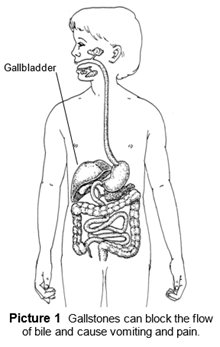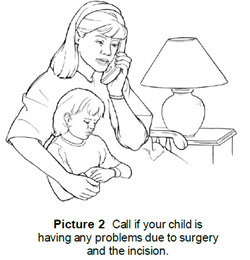Gallbladder Removal (Cholecystectomy)

The gallbladder is a small, pear-shaped organ on the right side of the belly (abdomen). It is tucked under the liver (Picture 1). The gallbladder stores a liquid called bile that helps with the digestion of fat. When a person eats food with fat in it, bile is released into the small intestine through small tubes called bile ducts. Gallbladder problems can be caused by gallstones. Gallstones are small hard stones that can block the flow of bile out of the gallbladder, causing pain and vomiting.
Symptoms of Gallstones
Your child may have one or all of these symptoms:
- Sharp pain in the abdomen, often after eating
- Feeling like they are going to vomit (nausea)
- Vomiting
- Indigestion or heartburn
- Fever
- Yellowing of the skin (jaundice)
Tests to Diagnose Gallstones
- Ultrasound, CT scan and X-rays - used to look for causes of belly pain and show gallstones
- Blood tests - these rule out other causes of belly pain
Treating Gallstones
Some children have gallstones and never have any problems. Sometimes, reducing fat (like cheese, butter, chocolate or ice cream) can help with pain. Symptoms often continue until the gallbladder is removed.
Understanding the Surgery
Your child can live a full life without a gallbladder. The surgery to remove the gallbladder is called a cholecystectomy (koe-lee-sis-TEK-toe-mee). Your child’s surgeon will talk with you about the method that will be used. It will be either a by a laparoscopic (a few small incisions) or open (longer incision) surgery. After the gallbladder is taken out, bile goes from the liver right into the small intestine, instead of being stored in the gallbladder. A doctor will give your child anesthesia to fall asleep so that they will not be awake during the surgery.
After the Surgery
- Your child will wake up in the Post Anesthesia Care Unit (PACU) near the surgery area. They may be in the PACU for 1 to 2 hours. As soon as your child wakes up from the anesthesia, they will go home or go to their hospital room.
- Your child will need to get up and walk around soon after surgery. Walking helps “wake up” the bowels. It also helps with breathing and blood moving around the body.
- Your child will get fluids and pain medicines through an IV (intravenous) line. Your child will get pain medicine by mouth when they can drink liquids.
- Your child may be discharged the same day of the surgery if their pain is well controlled with pain medicines taken by mouth and they are able to tolerate liquids by mouth.
- Your child will be discharged with Acetaminophen and Ibuprofen. Typically, children will not require any stronger pain medication to manage their pain after this surgery.
- You will receive a phone call from the surgery clinic to check on your child after surgery. You will not need to return to the hospital for follow up unless your child is not doing well after surgery.
Nutrition
Your child may be allowed to eat right after surgery if they do not have an upset stomach. When allowed to eat, they will be given clear liquids such as water, Jell-O®, popsicles, Sprite®, apple juice and broth. If your child has no problems drinking clear liquids, they can have a normal meal the next day.
Care of the Incision
- Your child will have 1 to 4 small incisions if the surgery is performed robotically or laparoscopically. Your child will have one larger incision if the surgery is performed open.
- If there are small strips of white tape (SteriStripsTM), by themselves or with a clear dressing (Opsite™) over the incisions, leave them in place. They will fall off on their own in 1 to 2 weeks. Do not remove them unless your child’s health care provider says it is okay.
- If your child has glue (Dermabond®) over the incisions, it will fall off on its own in 1 to 2 weeks. Do not remove it.
- Your child may take a shower or sponge bath. Do not scrub incisions. Clean gently around the incisions with soap and water. Dry incision sites well after the shower or sponge bath. Do not allow tub baths or swimming until 1 week after surgery.
Activity
Your child should play quietly for about 3 days at home, they may start normal activity except for no heaving lifting or sports for 2 weeks. Your child may return to school 1-2 days after surgery if they are doing well.
When to Call the Health Care Provider
After you are home, call your child’s health care provider (Picture 2) if:
- Any of the incisions become red and warm
- There is drainage or blood around the incision
- The incision becomes more tender or swollen
- The incision begins to separate (pull apart)
- Your child vomits or has nausea
- Fever goes over 101ºF by mouth or 102ºF rectally
- Abdomen becomes full and firm (distended) or your child acts like they have belly pain
- Your child cannot have a bowel movement

If you have any questions or other concerns, be sure to ask your child’s health care provider or call the surgery clinic at 614-722-3900.
HH-I-282 ©2008, Revised 2020, Nationwide Children ’s Hospital
